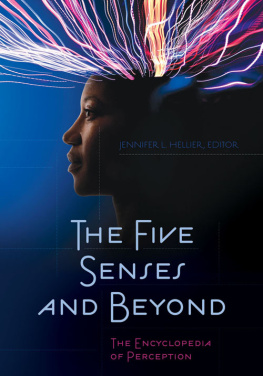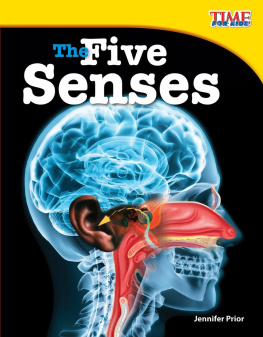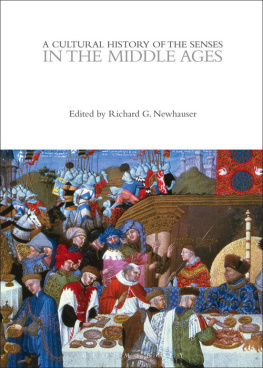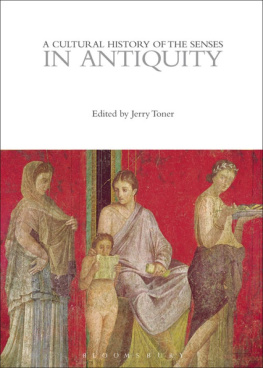The Five Senses
and Beyond
The Five Senses
and Beyond
The Encyclopedia of Perception
JENNIFER L. HELLIER, EDITOR

Copyright 2017 by ABC-CLIO, LLC
All rights reserved. No part of this publication may be reproduced, stored in a retrieval system, or transmitted, in any form or by any means, electronic, mechanical, photocopying, recording, or otherwise, except for the inclusion of brief quotations in a review, without prior permission in writing from the publisher.
Library of Congress Cataloging-in-Publication Data
Names: Hellier, Jennifer L., editor.
Title: The five senses and beyond : the encyclopedia of perception / Jennifer L. Hellier, editor.
Description: Santa Barbara, California : Greenwood, [2017] | Includes bibliographical references and index.
Identifiers: LCCN 2016021791 (print) | LCCN 2016023799 (ebook) | ISBN 9781440834165 (hardback) | ISBN 9781440834172 (eisbn) | ISBN 9781440834172 (ebook)
Subjects: LCSH: PerceptionEncyclopedias. | Senses and sensationEncyclopedias.
Classification: LCC BF311 .F53 2017 (print) | LCC BF311 (ebook) | DDC 152.103dc23
LC record available at https://lccn.loc.gov/2016021791
ISBN: 978-1-4408-3416-5
EISBN: 978-1-4408-3417-2
212019181712345
This book is also available as an eBook.
Greenwood
An Imprint of ABC-CLIO, LLC
ABC-CLIO, LLC
130 Cremona Drive, P.O. Box 1911
Santa Barbara, California 93116-1911
www.abc-clio.com
This book is printed on acid-free paper 
Manufactured in the United States of America
Contents
Preface
Understanding how the different sensory systems integrate information from the outside world to the brain for perception has been questioned and studied since the time of the ancient Greeks. With todays new technologies and research, neuroscientists have uncovered many physiological mechanisms of the senses and have learned how some can be associated with neurological deficits or disorders. Research has also developed new treatments to alleviate sensory deficits and in some cases to prevent further damage. Thus, the purpose of this encyclopedia is to provide a wide-ranging reference of the five main sensory systems and is written at a level easily accessible for high school and college students as well as the layperson. The encyclopedia provides insights into the discipline of neuroscience, covering both normative and neurological disorders and factors that promote general nervous system health. By addressing both ends of the spectrum, the encyclopedia presents a more holistic and comprehensive perspective of the fast-growing discipline of neuroscience.
This encyclopedia helps the reader understand how research is integral to understanding both normal and abnormal sensory function. The Five Senses and Beyond: The Encyclopedia of Perception contains more than 200 entries and pulls together topics that illuminate (1) the five basic senses and special senses, (2) anatomy and physiology related to the senses, and (3) organizations and individuals important to sensory research. To help the reader understand the basics of the brain and sensory systems, there are entries about brain anatomy and physiology, as well as how neurons talk to each other in brain circuits to provide normal function. There are various entries that discuss abnormal or dysfunctional sensory systems, which may develop into disorders or diseases. Finally, selected entries include references to research designs and experimental procedures commonly used to study sensory systems with examples from current and relevant clinical research as well as short biographies of famous scientists who furthered the knowledge of neuroscience and neurology. All entries include cross-references and further readings to aid in additional study.
The encyclopedia also includes 15 hands-on activity sidebars that give readers the chance to learn about the senses and their anatomy firsthand. From testing for eye dominance to discovering the interrelatedness between smell and taste to modeling brain anatomy with clay, these activities make the material more interactive.
The contributors to this work are all uniquely qualified to speak with authority regarding at least one aspect of the brain, the nervous system, and its disorders. The contributors include (1) neuroscientists who are immersed in cutting-edge research to better understand both normative and abnormal activities of the brain and the nervous system; (2) neurologists and family physicians who routinely diagnose and treat neurological diseases; and (3) public health professionals who work endlessly to educate the public about preventing neurodevelopmental disorders.
Acknowledgments
This project was a joy to work on as it allowed me to share my love of neuroscience research with everyone. However, I could not have completed this project without the help of my assistants Riannon Atwater and Renee Johnson. Both jumped in at the beginning with enthusiasm and worked endlessly with me on this reference. I thank Riannon and Renee for their dedication, time, and effort.
I thank Maxine Taylor, senior acquisition editor, for initiating this project and selecting me to be the lead editor. Her guidance and excellent editing skills have made me a better writer. I truly enjoyed working with Maxine during these past two years.
Lastly and most importantly I must thank my immediate and extended family for understanding how I needed to work during the weekends to make this a successful reference and for supporting me throughout this endeavor. I especially thank my husband, Chuck, and my two amazing sons, Jack and Sam.
Introduction
The nervous system helps an organism understand the environment around it and helps the organism respond and interact within its world. The most fundamental portion of the nervous system is its sensory system. This system consists of the five main sensesaudition (hearing), gustation (taste), olfaction (smell), touch, and vision (sight)as well as complex senses such as balance, interoception (also written as enteroception; sensory information from the walls of hollow internal organs), and proprioception (limb position).
Anatomical Organization of a Sensory System
The system consists of a network of neurons that work together to sense and then to process this information. The network of neurons will be described in three different divisions called first-order neurons, second-order neurons, and third-order neurons.
To begin with the sensing portion of the system, it involves a somatic (body) receptor that is within the skin, bones, muscles, joints, eyes, and ears. These specialized receptors will pick up sensory information and begin a nerve impulse. The receptor is part of the sensory neuron, which is considered the first-order neuron or primary afferent neuron for sensory information. This neuron comes from the periphery and will travel the afferent pathway (toward the central nervous system). For most of the sensory neurons, their cell body (or soma) is located in the dorsal root ganglion (a group of cell bodies outside of the central nervous system) just lateral of the spinal cord. For sensation to the head, neck, and face, these nuclei (a group of cell bodies inside of the central nervous system) are found in the brainstem and are named for the cranial nerve that carries the sensory and/or motor information to the central nervous system.
The second-order neuron is an interneuron. This secondary neuron will receive information from the first-order neurons synapse, where neuronal information is transferred from one neuron to another. Some of these second-order neurons may send their axons to cross over to the other side of the spinal cord or brainstem before carrying the information to the thalamus, which is a deep relay structure within the brain. All second-order neurons will synapse in the thalamus, except for the sense of smell.
Next page






